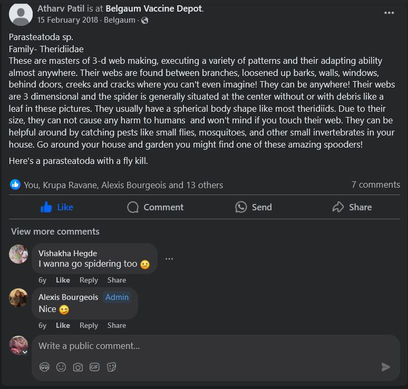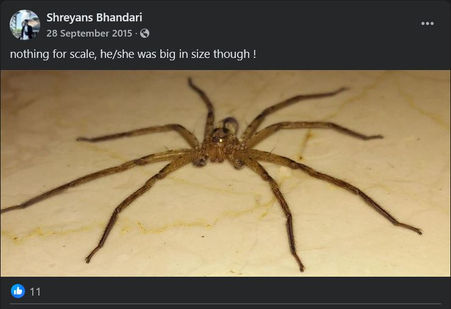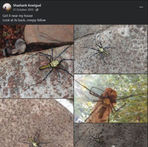
Spider Club of Belgaum
A UX case study for a platform that simplifies spider documentation and identification for enthusiasts and researchers.
Project synopsis
The Spider Club of Belgaum (SCOB) is a digital database documenting over 55 local spider species, compiled from four years of field research. It bridges the gap between researchers, enthusiasts, and the general public by providing an organized, user-friendly platform for spider identification and study.
Problem
People interested in studying or identifying spiders struggle with scattered, inaccessible, or jargon-heavy resources, making it difficult to learn, document, or contribute to research.
Analysis
-
Existing resources are often hidden behind paywalls, lack local data, or are too complex for non-experts
-
Enthusiasts rely on direct communication with experts for identification, thereby slowing down knowledge-sharing and documentation
Solution
SCOB compiles verified spider data, images, and field notes into an accessible, taxonomically structured platform. This helps users identify local species, compare observations, and contribute to spider research that goes beyond taxonomy.
Challenges
-
Balancing scientific accuracy with accessibility
-
Keeping the platform engaging and easy to navigate
Introduction
The Spider Club of Belgaum (SCOB) began as a simple quest: to identify a single spider in the wild.

The spider in question- Araneus viridiventris- identified by Alexis Bourgeois
©SCOB, 2024
What followed was a years-long journey of discovery, learning, and connecting with spider enthusiasts and researchers across the globe. Initially starting off as a Facebook group for sharing local spider sightings, it has grown into a repository of knowledge and inspiration.
The Problem
Lack of Accessible Spider Documentation
The photograph of a spider in 2015, that Google reverse image search and online databases failed to identify- triggered the following series of events. After seeking help from global researchers and engaging with Facebook spider groups, we realized the broader challenge: India lacked comprehensive spider documentation that was both visually engaging and scientifically credible.
Identifying a spider species is no easy task- existing resources are either too scattered, highly technical, or geographically limited. This gap in accessible, centralized documentation inspired the creation of SCOB - a platform to bridge knowledge gaps and foster curiosity.
While Belgaum is home to an incredible diversity of spiders, there was not a single resource showcasing their diversity, behavior, or ecological importance.
How It All Began
4+ years of meticulous research and observation led to a wealth of data- 17 spider families and over 55 species - but much of it was scattered- photos, behavior notes, and taxonomic information lived across emails, online entries, and Facebook groups.

The Facebook group we started in 2015 caught the attention of a lot of people but lacked organized documentation
The Goal
I envisioned a platform that could:
1. Create a verified and accessible database for spider species, starting with comprehensive documentation from Belgaum.
2. Turn years of field research into an engaging and user-friendly platform.
3. Simplify spider identification for enthusiasts and researchers, fostering a community that encourages accurate data sharing and collaboration.
How can we turn years of spider research into a platform that is accessible and engaging for all?
Research and analysis
Research Methods
-
Literature Review: Examined existing resources like Spiders of Borneo, online portals like World Spider Catalog, India biodiversity portal, etc. to understand what made spider documentation accessible and effective.
-
Engagement in Communities: Participated in global and regional spider groups to identify common pain points, including the complexity of scientific language and the significance of quality imagery.
-
Casual interviews with Researchers and Enthusiasts: Gathered insights on how taxonomy drives ecological studies, influencing the structure and content for SCOB.
Comparative Analysis
I analysed various spider documentation resources- identifying their strengths and limitations to highlight the need for an engaging, user-centric platform like SCOB




Various spider documentation databases- Clockwise from top left- World Spider Catalog, India Diversity Portal, SpiderID.com and Spiders of Borneo
1. World Spider Catalog (website)
✔ Comprehensive taxonomic database
☹ No descriptions or images - inaccessible for casual users
2. India Biodiversity Portal – SpiderIndia Group (website)
✔ Combines sightings with geolocation and environmental data
✔ Verification badges and moderators enhance credibility
☹ Uneven taxonomic coverage, some entries lack supporting data despite verification
4. SpiderID.com (website)
✔ User-friendly submission process, basic statistics, and automated descriptions
☹ Automated descriptions heavily favour U.S.-centric data
☹ Claims species-level classification with no verification or clear methodology
3. Spiders of Borneo (book)
✔ Detailed family and genus descriptions, engaging language, and observations on traits and behavior
☹ Static format limits accessibility and indexing
☹ Limited number of photos per genus
Defining the Audience
With a goal to make spider data more accessible and foster empathy for spiders, the primary users for SCOB would be:
1. Spider Enthusiasts
2. Researchers
3. Nature Lovers



" It's so difficult as a beginner to trust information on the internet about spider sightings. I can only rely on trusted individuals or Facebook groups with trustworthy moderators to ID a spider for me."
- Shubham, a spider enthusiast and amateur Arachnologist
" Spotting a spider in real life that I’ve seen on
SCOB (facebook group) feels so exciting! I feel like an expert when I can casually drop facts or name a spider I just saw "
- Parineeti, a nature enthusiast
" Building a taxanomic database is the very foundation of ecological research. It's the gruntwork in science that no one wants to do, but you just can't do without it "
- Dhruv, researcher and academician
The diverse perspectives of our target audience, emphasises on the value and impact of a comprehensive database like SCOB.
Key Insights and Takeaways
1. Documentation is foundational: Even when spider species cannot be immediately identified, recording details like appearances, behaviors, and habitats provides a foundation for future research. This includes potential discoveries like evolutionary trends or mimicry patterns.
2. Spider identification requires holistic data: Identifying spiders is not just about images. It demands ecological and taxonomic data for accuracy. This calls for creating a comprehensive platform for thorough documentation.
3. Community contributions enrich databases: The Facebook group demonstrated the power of community-driven efforts, with members enthusiastically sharing sightings, photos, and questions. However, the research highlighted the necessity of expert moderation to maintain scientific integrity.
4. Storytelling transforms perceptions: Interactions in the Facebook group showed that stunning visuals and captivating stories evoke curiosity, transforming fear into fascination. People expressed admiration for spiders after seeing beautiful images or reading behavior notes, which strengthened the idea that storytelling fosters both empathy and engagement.
By integrating these insights, SCOB aims be more than a resource—it can become a bridge between rigorous scientific documentation and public appreciation, blending accessibility with credibility.
Community contributions help populate database but also highlighted a need for expert moderation. The SCOB Facebook group created a movement by making scientific data easily accessible and digestible and sparking curiosity amongst the general public.
CRAFTING THE SOLUTION
Core Goals
Organization: Organize and preserve years of research into a centralized digital platform.
Accessibility: Create an intuitive, responsive interface that caters to both researchers and casual users.
Empathy and Curiosity: Use visuals and narratives to foster a connection between users and spiders, making learning delightful.
Reliability: Ensure only accurate and verified data is uploaded on the platform.
Design Decisions
The solution needed to balance rigorous documentation with an engaging user experience.
-
A taxonomy-driven structure ensures users can explore species by categories like family and genera
-
Visual storytelling combines high-quality images with intriguing behavioral notes to captivate both casual users and experts.
-
Allowing submissions only through mail rather than direct uploads to populate the database in the first release in order to maintain spiders identified and verified by experts to maintain scientific integrity of the platform- the decision to include the option to directly upload could be considered in a future iteration based on the volume of submissions.
Content Strategy and Structure

Information Architecture diagram showing the structure and navigations within the platform
-
Homepage has a summary of all the content that the website has to offer
-
Explore section has all the spiders arranged in a taxonomy-based structure and is primarily aimed at spider enthusiasts/researchers to let them explore and access all the documentation so far
-
Blog serves as an induction into the subject of the website and is primarily aimed at novice/casual users to understand arachnid ecology better

Lo-fi wireframes of the various pages from the navigation bar of the user flow (desktop version)
Delving into the interface
-
Creating a logo - it was designed to create a distinct visual identity for the platform


#C5C5C5
#D7D3D3
#414141
#FFFFFF
-
Keeping a minimal, de-cluttered interface with a neutral palette to focus on the content of the site

-
Interactive elements like displaying the number of genera documented within each family on hovering, encourages further exploration by providing more context with a simple action
Prototype & Final Screens
Here's a glimpse of the final screens for desktop and mobile versions of the website
You can access a fully functioning Figma prototype for SCOB here









Future Milestones
SCOB is a project that has developed alongside my growth as a designer, but there is more in store. It has the potential to evolve into a larger database, incorporating:
-
broader geographic coverage to include spiders from across India.
-
larger volumes of community contributions while maintaining expert moderation
-
integration of more data parameters to support advanced research, leading to possibility of filters and creation of species key to make spider identification more accessible to even casual users
-
dedicated pages for each genus and species
Some lessons I learned from this project



1. Balancing Accessibility and Engagement
Designing SCOB taught me the importance of creating a platform that is both informative for researchers and captivating for casual users. Striking this balance required thoughtful design choices that made scientific content accessible without compromising on engagement.
2. Designing for Scalability
Structuring data for 19 families and 55+ species with the optimistic foresight of continuous growth highlighted the need for scalable design solutions. It emphasized the importance of flexible layouts with modular elements, and data organization that could easily accommodate future additions.
3. Role of Empathy in Design
By integrating quality visuals and narrative-driven content, I realized how impactful design choices are to shift perceptions- by replacing fear and lack of information with curiosity and admiration for spiders.
Final words
SCOB was built to be more than just a database. It's a project driven by a desire to cultivate curiosity, empathy, and respect for the natural world. By combining detailed documentation and user research with thoughtful design, it shows how UX can make even very niche subjects feel relatable and inspiring.
Also check out -
A browser extension that helps integrate sustainability seamlessly into online fashion shopping







